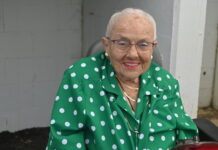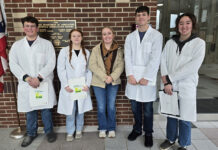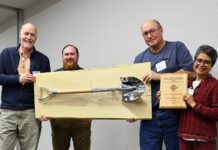STERLING, Ohio — Nearly 2,000 people from Wayne and surrounding counties visited Stollers’ Organic Dairy near Sterling, July 12, during the annual Dairy Twilight Tour, sponsored by the Wayne-Ashland Dairy Service Unit.
The farm is owned and operated by Scott and Charlene Stoller and their family. Scott and Charlene are in the process of transitioning to the next generation as their sons, Nelson, and his wife, Jessica, and Doyle and his wife, Naomi, take on ownership and day-to-day management decisions.
Family roles
Sons Warren, Clark and Toby are involved in the farm as employees until they turn 18, and join their brothers as part owners. As a family farm, everyone has their area of responsibility.
Nelson and Warren handle morning chores, while Doyle manages the pastures and fencing, as well as the heifers from weaning age to freshening. Nelson also helps Clark with the young calves, while Toby handles feed mixing duties.
Warren, Charlene, Naomi and Jessica handle the evening milking. Scott takes care of the odd jobs such as scraping the barns, feeding, and finishing milking and clean-up.

Scott Stoller’s younger daughters, Melody and Rose Mary, have inside chores until they are older. His oldest daughter, Lynelle, and her husband, Craig, operate their own organic dairy farm.
Charlene told the audience that although she was not raised on a farm, she enjoys life on the farm and working together as a family.
“I wanted to do my part,” she said.
She said milking in the old two-story bank barn was therapy for her after Scott had his accident 20 years ago. She said as the family worked together they sang, cried, prayed and shared the problems and events of the day.
Growing family
As the family grew, so did the size of the farming operation. The Stollers milk 160 Holsteins and have another 180 head of young stock. Because they rely on forage for a majority of their ration, they want a cow that fits their operation.
“The right cow for our herd is one that is problem-free, and has a calf every year,” said Scott. “We are a bull-bred herd, so we select bulls from cows that have been in the herd at least three or four lactations. We want a cow that is sound and can walk freely; she needs to have a nicely shaped udder and a low somatic cell score.”
Currently, the herd averages 18,000 pounds of milk with fat tests ranging from 4.0 to 4.5 and protein tests ranging from 3.0 to 3.2. They try to hold their somatic cell count between 100,000 and 150,000, according to Doyle.
“It gives consumers a better quality product in the end,” said Doyle.
High components and low somatic cell counts are important, according to Scott, because their processor pays nice bonuses for quality and components, on top of the base milk price.
They have been shipping organic milk since 2003 and are actively involved in Organic Valley, a farmer-owned co-op based out of La Farge, Wisconsin. In addition to their dairy and crops, the Stollers raise poultry, produce maple syrup and honey from their own beehives and raise their own fruit and vegetables.
Making changes
After Scott was injured, the couple knew they had to make some changes in their farming operation if Scott was going to continue to farm the farm that had been in the family for several generations.
In 2001, they moved toward an organic, foraged based operation with the cows doing much of the harvesting and the goal of keeping nutrients and soil on the farm and out of the streams.
Scott added that production in the herd is not limited by genetics, but instead it can be limited by energy in the forage.
“When we have a lot of cloudy days, it drops the energy level in the grass,” said Scott. “That impacts our production.”
Doyle said they prefer not to feed an expensive grain mix to the cows; instead they have a pasture-based feeding program and in a normal year, the cows are on pasture by mid-April and are off the pasture by Thanksgiving.
In the summer, 60 percent of the cows’ dry matter intake comes from the pasture and forty percent coming from a TMR of corn silage, haylage, ground grains, bean meal and minerals.
When the cows come off the pasture during the winter months, about 60 percent of the ration comes from the TMR with baleage and long-stemmed hay making up the balance of the ration.
“I am not afraid to pull them off the pasture instead of making mud,” said Doyle. “If your cows are fed at the expense of your pastures, you are no longer feeding your cows.”
New facilities
As the cropping practices have changed, so have the facilities on the farm. The Stollers made the transition from a stanchion barn to a free-stall barn and milking parlor. Scott said the stanchion barn worked for them because it was economical and efficient, but they spent too much time milking.
The new parlor has speeded up the process immensely and the only change, according to Scott, would be to make it a couple of stalls longer on each side.
He added that the addition of a space-eliminating gate in the holding area kept cows moving, improving the cow flow and speeding up the milking time because they weren’t stopping to move cows into the parlor.
Scott said building the new parlor came sooner than expected, but he is glad they made the change.
“Our sons really pushed for this; it speeds up milking,” he said. “Charlene, Jessica and Naomi really like it. It makes things easier for them, especially when we are in the fields.”
The Stollers farm about 750 acres of owned and rented ground. They currently have about 548 acres that have been certified for organic production, with another 207 acres in transition to organic.
All of the crops raised on the certified organic acres are fed to livestock, while crops from the ground in transition are sold off the farm until the three year transition process is complete.
“In a normal year, we are self-sufficient,” said Scott.
Crops include corn, beans, wheat, rye, alfalfa and clover, as well as some oat and a lot of pasture mixes. This year they have a 150-acre test plot of Italian Rye Grass that they are using as a nurse crop for their alfalfa seedings.
The Stollers hope to use this in their rotations in place of oats. Scott said a typical rotation on the farm starts with hay or clover, followed by corn, which is followed by beans or small grains which are under-seeded with clover, going back to hay.
“Our goal is to have 100 percent of the crop and pasture land growing something in the spring,” said Scott. “This helps control soil erosion and allows us to capture energy from the sun through photosynthesis. We try to capture as much energy as possible.”
Conservation efforts
They installed a tile line to direct all silage leachate into the manure storage ponds, water ways, contour strips and adopted forest stand improvement, upland wildlife habitat and riparian buffer zone management plans.
Charelene told the audience that as the boys were growing up, Scott trained the next generation to take over the farm by giving them responsibilities, allowing them to make mistakes and learn from those mistakes.
Today, that training has paid off as their sons are actively involved on the farm.
“Dad took me faithfully when I wasn’t much help,” said Doyle. “I hope I have paid him back. I want my little boy to have the same life that I did when I was growing up.” Nelson and Lynnell added that as a family, they did a lot together and there was never a dull moment around the farm.
Perhaps Warren summed it up the best when he told the audience that he wouldn’t exchange his experience growing up on the family farm for anything.
“I don’t want to do it, but I would lose my right hand to be like my dad,” he said.











